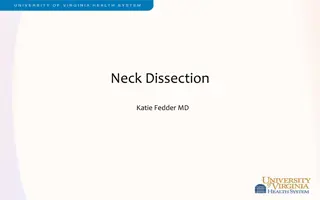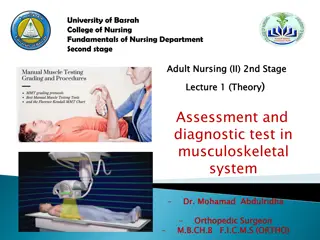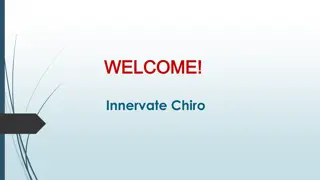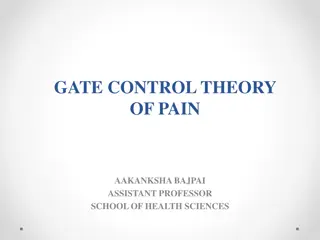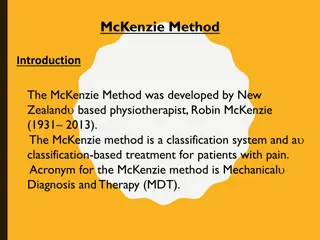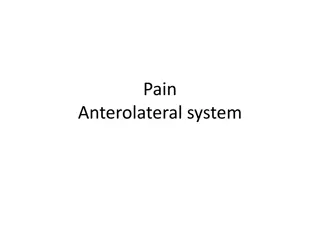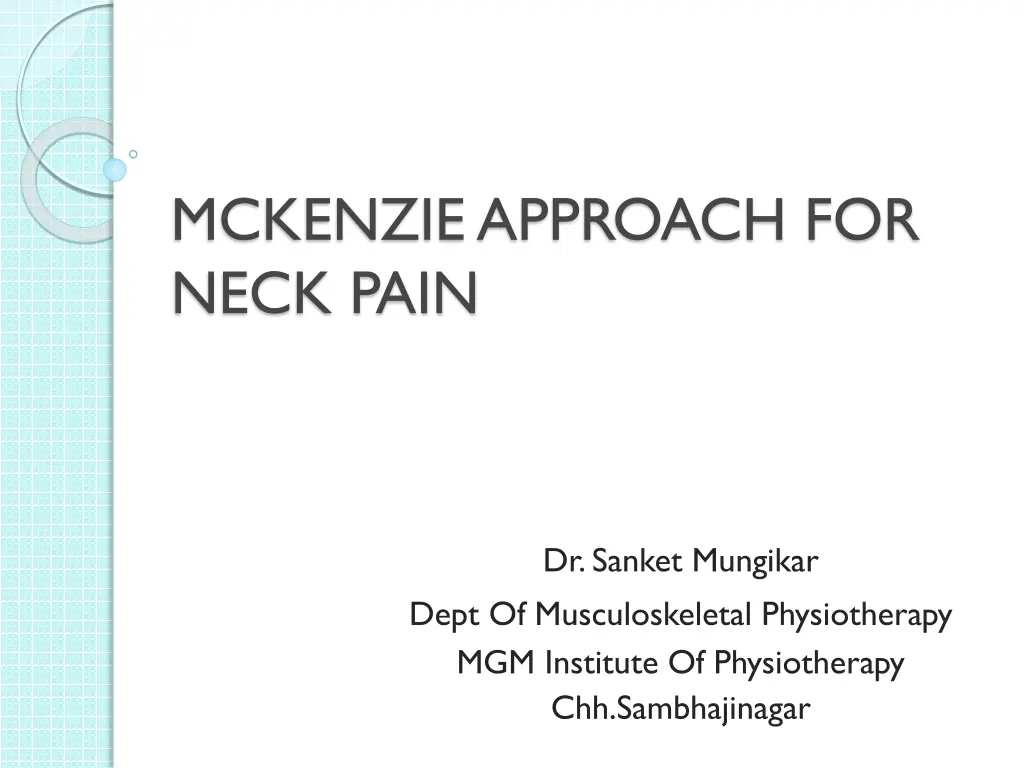
McKenzie Approach for Neck Pain: Empowering Patients Through Effective Treatment
Discover the McKenzie method, a patient-focused approach for musculoskeletal disorders, emphasizing self-treatment and empowerment. Learn about centralization and peripheralization in spinal disorder treatment. Addressing neck problems like arthritis, spondylosis, and more, this method offers insights into mechanical pain causes and potential complications.
Download Presentation

Please find below an Image/Link to download the presentation.
The content on the website is provided AS IS for your information and personal use only. It may not be sold, licensed, or shared on other websites without obtaining consent from the author. If you encounter any issues during the download, it is possible that the publisher has removed the file from their server.
You are allowed to download the files provided on this website for personal or commercial use, subject to the condition that they are used lawfully. All files are the property of their respective owners.
The content on the website is provided AS IS for your information and personal use only. It may not be sold, licensed, or shared on other websites without obtaining consent from the author.
E N D
Presentation Transcript
MCKENZIE APPROACH FOR NECK PAIN Dr. Sanket Mungikar Dept Of Musculoskeletal Physiotherapy MGM Institute Of Physiotherapy Chh.Sambhajinagar
DEFINATION: The McKenzie method (or mechanical diagnosis and therapy, MDT) is a system of diagnosis and treatment for spinal and extremity musculoskeletal disorders. The McKenzie method was introduced in 1981 by Robin McKenzie, a physical therapist from New Zealand. A feature of the method is emphasizing patient empowerment and self-treatment. MDT categorises patients complaints not on anatomical basis,but subgroups them by the clinical presentation of patients.
In the treatment by the McKenzie method disorders in the spine, which have repeated symptoms in the extremities, important place takes an Centralization - the symptoms movement from the distal segments of body to the proximal. Advent of centralization is a good signal and speaks of correctness actions being taken. And in contrast, peripheralization - the movement of pain from the spine to the extremities, indicates a worsening
INTRODUCTION: Neck problems are referred to in different ways such as arthritis in the neck, spondylosis of the neck, rheumetism, fibrositis, slipped disc; or, when it concerns pain extending into the arm, neuritis and neuralgia. Usually these aches and pain occur intermittently that is there are times in the day or there are days that no pain is felt. The symptoms may appear mysteriously, often for no apparent reason, and just as mysteriously disappear.
WHY NECK PAIN Mechanical pain occurs when the joint between two bones has been placed in a position that overstretches the surrounding soft tissues. Pain of mechanical origin may arise in the neck for the following reasons. The ligaments and other soft tissues which hold the vertebrae together can simply be overstretched without further damage. Overstretching may be caused by an outside force placing a sudden severe strain on the neck, for example due to an accident or during contact sport. More often overstretching is caused by postural stresses which place less severe strains on the neck over a longer time period.
Complications of another nature arise when the ligaments surrounding the disc are injured to such an extent that the disc loses its ability to absorb shock and its outer wall weakened. This allows the soft inside of the disc to bulge outwards and. In extreme cases, to burst through the outer ligament which may cause serious problems. When the disc bulge protrudes far enough backwards it may press painfully on a spinal nerve. This may cause some of the pains felt well away from the source of the trouble. For example in the arm or hand. Due to this bulging the disc become severely distorted and prevent the vertebrae from lining up properly during movement.
WHERE IS PAIN FELT The sites of pain caused by neck problems vary from one person to another. In a first attack pain is usually felt at or near the base of the neck, in the centre or just to one. Usually the pain subsides within a few days. In subsequent attacks pain may reach across both shoulders, to the top of one shoulder or the shoulder blade; and later Still to the outside or back of the upper am as far as the elbow; Or it may extend below the elbow to the wrist or hand and pins and needles or numbness may be felt in the fingers
Some people experience headaches as a result of neck problems. Often these headaches are felt at the top of the neck and the base and back of the head, on one or both sides; but they Can also spread from the back of the head over the top of the head to above or behind the eye, again on one or both sides.
Common causes of neck pain Sitting for prolonged periods: When we sit and relax in a chair, the head and neck protrude because the muscles that support them become tired. As the muscles tire they relax and so we lose the main support a good posture. The result is the protruded head posture. When the protruded head posture is maintained long enough, it causes overstretching of ligaments. Thus pain will arise in certain positions only. Once the protruded posture has become a habit and is maintained most of the time, it may also cause distortion of the discs contained in the vertebral joints. 1.
At this Stage movements as well as positions will produce pain. Neck problems. developed in this way are the consequence of postural neglect. Poor neck posture is not the only cause of neck pain. It is however one of the main causes and the most troublesome perpetuating factor. During sitting, the position of the low back strongly influences the posture of the neck. If the low back is allowed to slouch, it is impossible to Sit With head and neck pulled backwards. Once we have been sitting in a certain position a few minutes, our body sags and we end up sitting slouched with a rounded low back and protruded head and neck.
Bad sitting posture. Protruded head posture Poor neck posture. The result of jnsuflicicient, low back support.
Environmental factors: The design of transportation, commercial and domestic seating only encourages poor postural habits. Rarely do the Chairs available give adequate support to low back and neck and, unless a conscious effort made to sit correctly, we are forced to Sit badly. Although the poor design of furniture contributes to the development of neck problems.
2. Lying and Resting The next most frequent cause of neck pain is postural stress in the lying position. If you wake up in the morning with a Stiff and painful neck that was not causing problems the night before, there is likely to be something wrong with the surface on which you are lying or the position in which you sleep. Once you are asleep you may just regularly Change your position or you may toss and turn. Unless a certain position causes so much discomfort that it wakes you up, have no real idea of the various positions you assume while sleeping.
3. Working in Awkward Positions or Cramped Spaces Some jobs can only be performed in positions which are likely to cause overstretching of the neck . These jobs may require the adoption of the sitting position and usually they involve precision work. Alternatively, they may have to be performed in cramped spaces or with head and neck in awkward static positions.
GENERAL GUIDELINES AND PRECAUTIONS: When you are exercising for pain relief, you should move to the edge of the pain or just into the pain, then release the pressure and return to the starting position. But when are exercising for stiffness, the exercises can be made more effective by using your hands and gently but firmly applying overpressure in order to obtain the maximum amount of movement. Postural correction and maintenance of the correct posture should always follow the exercises. Once you no longer have neck pain, good postural habits are essential to prevent the recurrence of neck problems.
EXERCISES: EXERCISE 1: Head retraction in sitting: Head retraction means pulling the head backwards. Position: Sit on a chair, or Stool, look straight ahead and allow yourself to relax completely. Procedure: Move your head slowly but steadily backwards until it is pulled back as far as you can manage. It is important to keep your Chin tucked down and as you do this. Once you have maintained this position for a few seconds, you should relax and automatically your head and neck will protrude again.
Each time you repeat this movement cycle you must make sure that the backward movement of head and neck is performed to the maximum possible degree. The exercise can be made effective by placing both hands on the chin and firmly pushing the head even further. Dosage: the exercise should be repeated ten times per session and the sessions Should be spread evenly six to eight times throughout the day. This means that you should repeat the sessions about every two hours.
The relaxed position allows the head to protrude The retracted position. Retracted with overpressure
EXERCISE 2: neck extension in sitting: Extension means bending backwards. This exercise should always follow exercise I. Position: Remain seated, repeat exercise I a few times, then hold your head in the retracted position. Now you are ready to start 2. Procedure: Lift your Chin up and tilt your head backwards as in looking up at the Sky. Do not allow neck to move forwards as you do this. With your head tilted back as far as possible you must repeatedly turn your nose just half an inch (about 2 cm) to the right and then to the left of the midline, all time attempting to move head and neck even further backwards
Once you have done this for a few seconds, you should return your head to the starting position. Again, each time you repeat this movement Cycle you must make Sure that neck extension is performed to the maximum possible degree. Dosage: This exercise is to be performed ten times per and the sessions should be spread evenly six to eight times per day. If your pain is too severe to tolerate exercise 2, you Should replace it With exercise 3. Once you are fully practised in exercises I and 2 separately, you can combine these two exercises successfully into one exercise.
EXERCISE 3: head retraction in lying: Position: Lie face up with your head at a free standing edge Of the bed - for example, lie across a double bed or with your head at the foot-end of a single bed. Rest head and Shoulders flat on the bed and do not use a pillow. Now you are ready to start exercise 3. Procedure: Push the back of your head into the mattress and at the same time pull your chin in. The overall effect should be that head and neck move backwards as far as possible while you keep facing the ceiling. Once you have maintained this position for a few seconds, you should relax and automatically head and neck will return to the starting position.
Dosage: When you have completed ten head retractions, you must evaluate the effects of this exercise on the pain. If the pain has centralised or decreased in intensity, you can safely continue this procedure. In this case you should repeat the exercise ten times per session and spread the sessions evenly six to eight times throughout the day or night. But if the pain has increased considerably or extends further away from the spine, or it you have developed pins and needles or numbness in the fingers, then you must stop the exercise and seek advice.
EXERCISE 4: neck extension in lying: This exercise should always follow exercise 3. Position: Again you must lie face up of the bed. Procedure: Before you can start exercise 4 you must place One hand under your head and move up along the bed until head, neck and the top of your shoulder are extended over the edge of the bed. While supporting head you should lower it slowly towards the floor. Now you remove your hand bring head and neck as far backwards as you Can and try to see as much as possible of the floor directly under you. In this position you must repeatedly turn your nose just half an inch (about 2 cm) to the right and then to the left of the midline, all the time attempting to move head and neck further backwards.
Once have reached the maximum amount of extension, you should try to relax in this position for about thirty seconds. In order to return to the resting position, you must first place one hand behind your head, then assist your head back to the horizontal position and move down along the bed until your head is lying on the bed again. It is important that, following this exercise, do not rise immediately but rest for a few minutes with your head flat on the bed. Dosage: Until the acute symptoms have subsided exercise 4 is to follow exercise 3 and it should be done only once per session. Once you no longer have severe pains, exercises 3 ard 4 should be replaced with exercises 1 and 2.
EXERCISE 5: side bending of the neck Position: Sit on a chair, repeat exercise I a few times, then hold head in the retracted position. Now you are ready to Start exercise 5. Procedure: Bend neck sideways and head towards the side on which you feel most of the pain. Do not allow the head to turn. In other words, you should keep looking straight ahead and Should not bring your nose but your ear close to the Shoulder. It is important that you keep the head well refracted as you do this.
The exercise can be made more effective by using the hand of the painful side, placing it over the top of your and gently but firmly pulling your head even further towards the painful side. This exercise is used specifically for the treatment of pain felt only to one side or pain felt much more to the one side than to the other. Dosage: Until the Symptoms have centralised exercise 5 is to be repeated ten times per session and the sessions are to be spread evenly six to eight times throughout the day.
EXERCISE 6: neck rotation: Rotation means turning to the right and left. Position: Sit on a chair, repeat exercise i a few times, then hold your head in the retracted position. Now you are ready to start exercise 6. Procedure: Turn your head far to the right and then far to the left as before crossing the street. It is important that you keep the head well retracted as you do this. If you experience more pain on turning to the one side than to the other, you should continue to exercise by rotating to the most painful side and on repetition the pain should gradually centralise or decrease in intensity. However, should the pain increase and fail to centralise, you must continue to by rotating to the least painful side.
Once you have the same amount of pain or no pain but only stiffness when turning to either side, you should continue to exercise by rotating to both sides. The exercise can be made more effective by using both hands and gently but firmly pushing your head even further into rotation. Once you have maintained the position of maximum rotation for a few seconds, you should return your head to the starting position. Dosage: the exercise is to be performed ten times per session and the sessions are to be spread evenly six to eight times throughout the day. Whether centralisation or reduction of the pain has taken place or not exercise 6 must always be followed by exercises I and 2.
EXERCISE 7: neck flexion in sitting Position: Sit on a chair, look straight ahead and allow yourself to relax completely. Now you are ready to start exercise 7. Procedure: Drop your head forwards and let it rest with the chin as close as possible to the chest. Place your hands behind the back of your head and interlock fingers. Now let your arms relax so that the elbows point down towards the floor. In this position, the weight of the arms will pull your head down further and bring your chin closer to the chest.
The exercise can be made more effective by using the hands and gently but firmly pulling your head onto the chest. Once you have maintained the position of maximum neck flexion for a few seconds, you should return head to the starting position. Dosage: This exercise should be repeated only two or three times per session and the sessions should be spread evenly six to eight times throughout the day. When used in the treatment of headaches, exercise 7 should be performed in conjunction with exercise 1 When used in the treatment of neck pain or stiffness, exercise 7 must always be followed by exercises1and 2.
SUMMARY OF EXERCISES: In order to treat present neck problems successfully you must do the following: At all times: correct your posture and maintain the correct posture. When in acute pain: if possible, perform exercises 1 and 2; if not possible, then do exercises 3 and 4. When pain more to one side and not responding: first exercise 5, later exercises 1and 2. When acute pain has subsided: exercises 6 and 7, always followed by exercises 1 and 2
In order to prevent future neck problem successfully you must do the following: At an times: maintain good postural habits, When no pain or stiffness: twice per day exercise 6, always followed by exercises 1 and 2. At first sign of recurrence: postural correction and exercises 1 and 2 at regular intervals that is. Ten times per session and six to eight sessions per day.
1. Efficacy Of Mckenzie Protocol On Non-specific Neck Pain. Reham Hussein Diab, Rania Hakem Hamed, Ibrahem Mustafa Mustafa International Journal of Physiotherapy and Research, 2016. AIM: to evaluate the effect of McKenzie protocol on CROM, intensity of pain, and neck functional activity level in the management of non specific neck pain patients. METHODOLOGY: Thirty patients 30-50 years of age was assigned in two groups. The traditional treatment was applied in the form of U.S and strengthening exercises program 3 sets of 5 repetitions, once a day, 3 times a week over a period of 6 weeks.
McKenzie protocol of treatment: Fifteen Patients with non-specific neck pain had received McKenzie protocol additionally to the traditional treatment. OUTCOME MEASURES: goniometer, visual analog scale (VAS), and Copenhagen neck functional disability scale CONCLUSION: McKenzie protocol of treatment additionally to traditional treatment is effective in increase CROM, decrease pain and increase functional activity in non specific neck pain patients.
2. Compare the effectiveness of McKenzie Techniques and Isometric Strengthening Exercise In Patients with Cervical Radiculopathy Niraj Kumar, Shama Praveen, et al. European Journal of Molecular & Clinical Medicine, 2020. AIM: To compare the effectiveness of McKenzie techniques and Isometric Strengthening Exercise in patients with cervical radiculopathy. METHODOLOGY: A convenience sample of 30 subject with cervical radiculopathy randomly assigned into two groups like group A and B. The Group A subject were received McKenzie Technique (MT), Hot Pack and Postural Correction.
The Group B subject were received Isometric Strengthening Exercise (ISE), Hot Pack and Postural Correction. All two groups were treated for four week. OUTCOME MEASURES: Visual analogue Scale (VAS) and Functional rating index (FRI) CONCLUSION: In the present study, there was significant difference between the McKenzie treatment, Isometric strengthening exercise treatment for cervical radicular pain. The McKenzie protocol has been found to be more beneficial that the Isometric Strengthening exercise
3. Stabilization Versus Mckenzie Exercises In Patients With Mechanical Neck Dysfunction Tarek Ammar International Journal of Physiotherapy and Research, 2018. AIM: The objective of this study was to compare stabilization exercises to McKenzie exercises in patients with MND. METHODOLOGY: 27 participants were randomly allocated to the stabilization group (n=14) and the McKenzie group (n=13). Participants in both groups received the conservative physical therapy program (heat intervention, ultrasound and neck ROM exercises).
The first group received the cervical stabilization which included the craniocervical flexion exercises. The second group received the McKenzie exercises in addition to the conservative program. The McKenzie exercises included head retraction and neck extension in sitting position, head retraction and neck extension in supine position, left and right lateral bending, head turning, and neck flexion in sitting position. OUTCOME MEASURES: VAS, NDI, goniometry. CONCLUSION: Both programs were equally effective in improving pain, disability, and range of motion of patients with MND.
REFERENCES: Robin Mckenzie, Treat Your Own Neck, 2nd edition. Robin Mckenzie, 7 Steps to Painfree Life. Ammar T., Stabilization Versus Mckenzie Exercises In Patients With Mechanical Neck Dysfunction. 2018. International Journal of Physiotherapy and Research Niraj Kumar, Shama Praveen, et al., Compare the effectiveness of McKenzie Techniques and Isometric Strengthening Exercise In Patients with Cervical Radiculopathy. 2018. International Journal of Physiotherapy and Research


